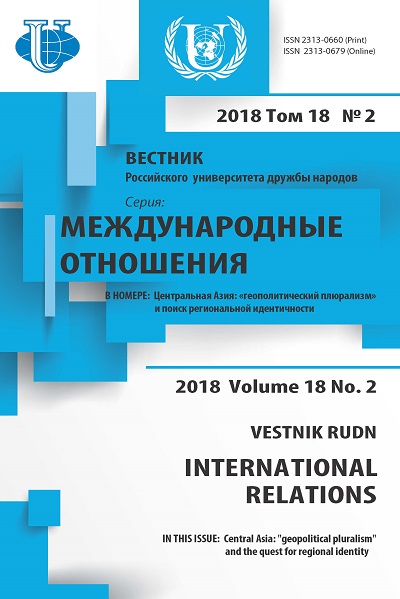EURASIANISM: TERMINOLOGICAL AMBIVALENCE
- Authors: Bazavluk S.V.1
-
Affiliations:
- RUDN University (Peoples’ Friendship University of Russia)
- Issue: Vol 18, No 2 (2018): Central Asia: “geopolitical pluralism” and the quest for regional identity
- Pages: 273-283
- Section: THEMATIC DOSSIER
- URL: https://journals.rudn.ru/international-relations/article/view/18879
- DOI: https://doi.org/10.22363/2313-0660-2018-18-2-273-283
Cite item
Full Text
Abstract
Despite the fact that a lot of research has been devoted to the study of Eurasianism, both in Russia and abroad, the international scientific community seems to still lack a common understanding of both the term “Eurasianism” and its derivatives. And we can talk not only about the socio-political, cultural, philosophical and religious definition of these concepts, but even about the geographical. If the difference in the humanitarian aspects of this issue can be explained in terms of the difference between the social system, ideology, and political structure, then the divergence in the geographical understanding of the Eurasian space and its borders can cause surprise. At the same time, after the collapse of the Soviet Union, Western scientists began to resort more and more geographically to the regionalization of the world political map, dividing the regions into increasingly smaller fractions right up to the redrawing of national borders, justifying in their writings the emergence of new political entities as a natural course of history, bloc approach of the Cold War period, but also the basic constants of geopolitical science about the confrontation of two global forces: sea and land. In terms of the same geopolitics, the land forces are represented by the “world island”, Heartland or Eurasia. However, according to the English dictionary Collins, the term “Eurasia” since 2006, the number of its uses in the English-language literature began to grow rapidly, breaking all records of use, since its inception, and occupying a place of honor among other 30,000 most common words. It seems that this interest is caused by the West's awareness of the fact that Russia was able to overcome the turbulence of the nineties and gradually began to restore its positions, primarily in the outward political arena. Thus, before our eyes there is a return to the topic of Eurasianism among international scholars, but already in new geopolitical realities. With the change in realities, the perception of the basic category of geopolitics-space also changed, which in turn led to a difference in the interpretation of the term “Eurasia” and its derivatives.
Keywords
About the authors
Sergey Viktorovich Bazavluk
RUDN University (Peoples’ Friendship University of Russia)
Author for correspondence.
Email: bazavluk_sv@rudn.university
Senior Lecturer of the Department of Theory and History of International Relations, Advisor to the Vice-Rector of the Peoples’ Friendship University of Russia
References
- Brzezinski, Z. (1998). The Grand Chessboard. Moscow: Mezhdunarodnye otnosheniya.
- Brzezinski, Z. (2012). Strategic Vision: America and the Crisis of Global Power. Moscow: Astrel'.
- Dugin, A.G. (1992). Rusia. Misterio de Eurasia. Madrid: Grupo Libro88.
- González-Ruiz, M., Santos, C., Jordana, X., Simón, M., Lalueza-Fox, C., Gigli, E. & et al. (2012). Tracing the Origin of the East-West Population Admixture in the Altai Region (Central Asia). PLoS ONE, 7(11). DOI: https://doi.org/10.1371/journal.pone.0048904.
- Gumilev, L.N. (2004). Ancient Rus and Great steppe. Moscow: Astrel', AST publ. (In Russ.).
- Hara-Davan, E. (1929). Genghis Khan as general and his heritage. Belgrad.
- Ivina, A.A. (Eds.). (2004). Philosophy: Encyclopedic dictionary. Moscow: Gardariki publ. (In Russ.).
- Johnson, R. (2006). Spying for Empire: The Great Game in Central and South Asia, 1757—1947. London: Greenhill.
- Laruelle, M. (2008). Russian Eurasianism: An Ideology of Empire. Washington, DC: Woodrow Wilson Center Press with Johns Hopkins University Press.
- Laruelle, M. (2015). Eurasia, Eurasianism, Eurasian Union: Terminological Gaps and Overlaps.
- Ponars Eurasia. URL: http://www.ponarseurasia.org/node/7789 (accessed: 01.12.2017).
- Mackinder, H.J. (1904). Geographical pivot of history. The Geographical Journal, 23, 421—437.
- Nazarbaev, N.A. (2003). The world epicenter. Almaty: Atamura publ. (In Russ.).
- Nazarbaev, N.A. (2000). Society transformation strategy and revival of the Eurasian civilization. Moscow: Ekonomika publ. (In Russ.).
- Nysanbaev, A.S. (2001). The mutual understanding philosophy. Almaty: Glav. red. “Қazaқ enciklopediyasy” publ. (In Russ.).
- Savickij, P.N. (1993).Eurasianism. In: Russia between Europe and Asia. Eurasian temptation. Antologiya. Moscow: Nauka. p. 100—106. (In Russ.).
- Ye, Z. (2011). Inside China's Grand Strategy. Kentucky: The University Press of Kentucky.











